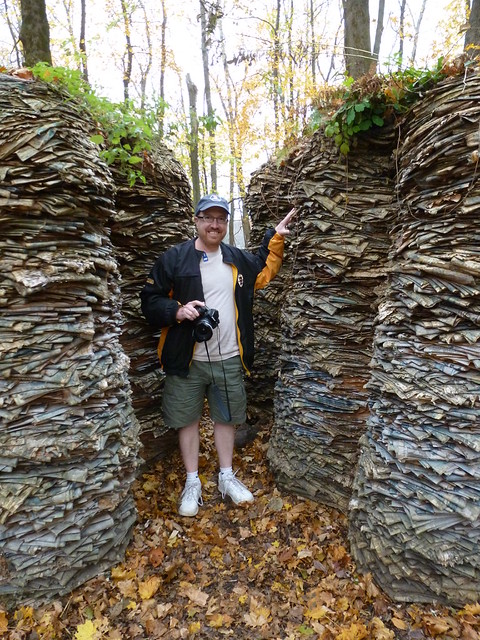One of my favorite pieces from yesterday’s trip to the deCordova Museum and Sculpture Park was Steven Siegel’s “Big, with rift,” a site-specific installation utilizing the media of “paper and flora.” The piece is an assemblage of newspapers stacked in what appears to be a rectangular cellar hole surrounded by stone walls. You can view the pillars of piled paper from above—that is, from ground level—or you can walk down a gentle slope to stand alongside them at cellar-level, the stacks towering nearly as tall as the walls that surround and shelter them.
The newspapers that make up “Big, with rift” are well-weathered and gradually decaying, with vegetation sprouting from their upper layers: the printed word returning to the elements. I was amazed to realize, however, that this installation has been at the deCordova since the summer of 2009: somehow, I’d missed it during my last trip there, and I wouldn’t have guessed that freestanding paper piles could so successfully weather four years’ worth of New England seasons.
Viewing (slowly) decaying paper piles alongside much older, well-weathered stone walls is particularly evocative: how long, exactly, will any of our words last? Today’s news is tomorrow’s compost, and the most insightful of today’s newspaper articles will wrap tomorrow’s fish and chips or line next week’s canary cage. The spoken word is ephemeral—no more solid than a breath—and paper is only a bit more permanent: paper may cover rock, but rock outlasts us all. But the premise behind the saying “the pen is mightier than the sword” is that weighty words do indeed last, echoing down the ages to transmit wit and wisdom from one generation to the next.
What is, after all, a newspaper column but a structural thing: a pile of words we build as a kind of warren, a burrow of beliefs we retreat to, entrenched. What I declare today might not match what I believe tomorrow, but we write on, regardless, as if words were capable of creating a lasting legacy: a cumulative weight of word upon word that fills in, plasters, and supports our notion of self. How many of us shore up the cellar-holes of identity with pillars of opinion, our words as much as our clothes making the man?
Books are believed to be more lasting than newspaper, magazine, or (especially) blog articles: books, after all, are bound, their covers providing a kind of protection, and we count as “ephemera” the scraps of paper—posters, pamphlets, and ticket stubs—that recount the mundane minutiae of our days. But perhaps the paper trails we each leave tell just as much about us as anything, a grocery or to-do list speaking proverbial volumes.
If our stone-walled cellars could talk, they’d have many a tale to tell, but so would the castoff papers that pile in our basements, offices, and drawers. Books may be bound, but newspapers are un-bound, papering over the rift between sacred and profane, serious and silly, local and global: all the words, in a word, that are fit to print.
This is my Day 11 contribution to NaBloPoMo, or National Blog Posting Month, a commitment to post every day during the month of November: thirty days, thirty posts.






Nov 11, 2013 at 3:42 pm
I adore this post. The sculpture and the thoughts it evoked in you are so moving. In North Carolina, we used to have a similar sculpture called “To see Jennie smile.” http://www.flickr.com/photos/ncma/3327145210/
It was removed about three years ago because it had mostly succumbed to the elements.
LikeLike
Nov 12, 2013 at 10:37 am
Oh, thank you for sharing that! I’d googled to learn more about the installation of this particular piece, but I didn’t look up Siegel’s other works. I can see how a “top heavy” work would have to be removed before it fell on someone.
LikeLike
Nov 11, 2013 at 3:50 pm
that is one of the coolest things I’ve seen in a while … I would have loved to have been standing beside you, inhaling the scent of decaying words, surrounded by the sounds of nature … thanks for sharing this very inspiring installation, and the photos, as well as your accompanying thoughts about the impermanence of our words
LikeLike
Nov 12, 2013 at 10:39 am
Right now, I think the scent of decaying leaves is stronger than that of decaying paper. This piece is particularly apt during autumn, I think, because of the similarity of both kinds of detritus.
LikeLike
Nov 11, 2013 at 4:40 pm
Astonishing work and so beautiful too! I too wish I could stand there. Thanks so much for featuring this so eloquently, Lorianne.
LikeLike
Nov 12, 2013 at 10:40 am
I’m glad you enjoyed it! It was a pleasant surprise at the end of a trail I’d never explored before, so I’m happy to take you along, virtually.
LikeLike
Nov 13, 2013 at 2:34 am
Love it. As a former newspaper guy, I can especially appreciate the transience of newspapers! And now, as a librarian, I’ve been noticing how transient even books are. I always thought of books as relatively permanent things, to be passed down through generations — but seeing how many get literally worn out, destroyed, or just discarded and/or recycled because they remain unread has really opened my eyes to their impermanence.
LikeLike
Jan 6, 2014 at 3:49 pm
Lorianne,
I just came across your blog and was happy to read your words and see the pictures. Your take on Big with Rift is a good one, and I always appreciate it when someone sees something in my work other than the saving of the earth through recycling . I have not been there in several years and it looks pretty good. This one should last quite a while. Please keep me posted.
Regards,
Steven Siegel
LikeLike